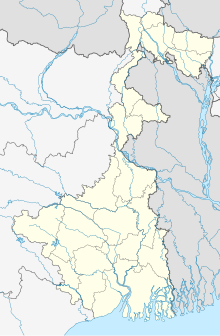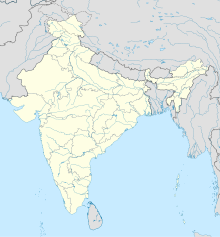|
Sripur Area
Sripur Area is one of the 14 operational areas of Eastern Coalfields Limited located in Asansol subdivision of Paschim Bardhaman district in the state of West Bengal, India. Geography
3km 2miles
Damodar River
ECL Satgram Area Office A
Satgram Incline Colliery U
Chapui Khas Colliery U
Ratibati Colliery U
Nimcha Colliery U
Ardhagram Project O
Kalidaspur Project O
JK Nagar Project O
Pure Searsole Colliery U
Mithapur Colliery U
Satgram Project O
Bhanora Colliery U
Damra Colliery U
ECL Sripur Area Office A
Adjoy II Colliery U
S.S.Incline U
Ningah Colliery U
Ghusick Colliery U Collieries in Sripur and Satgram Areas of Eastern Coalfields U: Underground Colliery, O: Open Cast Colliery, S: Mining support, A: Administrative headquarters Owing to space constraints in the small map, the actual locations in a larger map may vary slightly LocationSripur Area is located around 23°41′06″N 87°02′52″E / 23.684889°N 87.047754°E The Sripur Area is bounded by the rural areas Jamuria CD Block on the north, Pandaveswar Area on the east, Satgram Area on the south, and neighbourhoods of Asansol and Barabani CD Block/Salanpur Area on the west.[1][2][circular reference] The map alongside shows some of the collieries in the Areas. However, as the collieries do not have individual pages, there are no links in the full screen map. CollieriesAs per the Shodhganga website, collieries in the Sripur Area are: Ghusick, Nigah, S.S.Incline, Jamuria, Sripur, K.D.Incline, Adjoy II, Bhanora, Kalipahari and Damra.[3] As per ECL website telephone numbers, operational collieries in the Sripur Area in 2018 are: Bhanora West Block Colliery, Girmint Colliery, New Ghusick Colliery, Kalipahari Colliery, Ningha Colliery and S.S.I. Colliery.[4] Mines clusterCluster No. 8 is in the west-central portion of Raniganj Coalfield and spans over four geological blocks, namely Sripur, Satgram, Ningha and Bhanora. The mines are under the administrative control of Sripur and Satgram Areas of ECL. As of 2015–16, the composition of the cluster is as follows:[5] 1. Bhanora underground mine, with normative annual production capacity of 0.2 million tonnes and peak annual production capacity of 0.3 mt, had an expected life of over 20 years. See also – Salanpur Area#Mining plan for Bhanora West UG mine and Bhanora West OC patch  Illegal coal miningIndia is the third largest coal producer in the world. Mining is a highly organized industry, but there are gaps and loopholes. Beyond, or rather underneath, the well-organised industry, there is a large sector described as illegal mining. According to Haradhan Roy, the veteran political leader and trade unionist, about a million tonnes of coal are produced by illegal collieries in Raniganj alone. The total annual national production from such mines in India is not less than 20 million tonnes. In 2001 there were at least 33 identified sites of unauthorized mining in Raniganj. Of these many were in Salanpur, Sripur, Satgram and Sodepur Areas. Seven are outside ECL's lease-hold land. However, apart from the identified areas, such activities are spread across the entire region.[6] Systematic mining and movement of coal by the railways, started in the mid-nineteenth century in the Raniganj Coalfields, led by Carr, Tagore and Company.[7][8] The conventional "board and pillar" system was used in Indian underground collieries. In this system coal pillars are left behind to support the roof and the vacant space was not always filled with sand. ECL leaves a mine as soon as it is ‘uneconomic’, leaving the remaining coal for others to scavenge upon.[6] There are around 1,380 abandoned pits and inclines of ECL in the region.[9] The veteran CITU leader, Sunil Basu Roy, described the workers of the illegal mines as "the wretched on the earth" – they have nowhere else to go and no other means of survival. In Gourandi village, near Asansol, around 5,000 people work in shifts in an open cast mine. Work in such mines are labour-intensive and machines are unknown. The poor who rush into such jobs come from all segments of society, the Adivasi and other locals and migrants. They are quite often in the news when accidents occur.[6] 
5km 3miles
Ajay River
Damodar River
Jamuria N
Raniganj N
Asansol MC
ECL Kenda Area Office
ECL Kunustoria Area Office
ECL Satgram Area Office
ECL Sripur Area Office
Bahadurpur R
Churulia R
Ballavpur CT
Raghunathchak CT
Sahebganj CT
Egara CT
Baktarnagar CT
Amkula CT
Murgathaul CT
Chelad CT
Belebathan CT
Banshra CT
Jemari (Jaykaynagar) CT
Chapui CT
Ratibati CT
Parasia CT
Kenda CT
Chinchuria CT
Nimsa CT
Topsi CT
Kunustara CT Cities and towns in the eastern portion of Asansol Sadar subdivision in Paschim Bardhaman district MC: Municipal Corporation, CT: census town, N: neighbourhood, R: rural centre Owing to space constraints in the small map, the actual locations in a larger map may vary slightly SubsidenceTraditionally many underground collieries left a void after taking out the coal. As a result, almost all areas are facing subsidence. The entire stretch of Grand Trunk Road from Andal to Barakar passes through a subsidence-prone area. As per CMPDIL, there were 8 points of subsidence in the Sripur Area involving 1,046.92 hectares of land.[10] AccidentAmongst the major accidents in Indian coal mines in the post-independence period, only one has occurred in what is now the Sripur Area, On 14 March 1954, 10 persons were killed in an explosion of fire damp at Damra Colliery, then owned by Kalipahari Coal Company.[11][12][13] MigrantsPrior to the advent of coal mining, the entire region was a low-productive rice crop area in what was once a part of the Jungle Mahals. The ownership of land had passed on from local adivasis to agricultural castes before mining started. However, the Santhals and the Bauris, referred to by the colonial administrators as "traditional coal cutters of Raniganj" remained attached to their lost land and left the mines for agricultural related work, which also was more remunerative. It forced the mine-owners to bring in outside labour, mostly from Bihar, Odisha and Uttar Pradesh. In time the migrants dominated the mining and industrial scenario. The pauperization and alienation of the adivasis has been a major point of social concern.[6][14] Transport
The Andal–Jamuria–Sitarampur branch line passes through the Sripur Area.[15] References
|
|||||||||||||||||||||||||||||||||||||||||||||||||||||||||||||||||||||||||||||||||||||||||||||||||||||||||||||||||||||||||||||||||||||||||||||||||||||||||||||||||||||||||||||||||||||||||||||||||||||||||||||||||||||||||||||||||||||||||||||||||||||||||||||||||||||||||||||||||||||||||||||||||||||||||||||||||||||||||||||||||||||||||||||||||||||||||||||||||||||||||||||||||||||||||||||||

